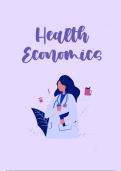Samenvatting
Health Economics Summary
The summary is written in alignment with the course lectures, material including both the book and the lecture slides. Please message me if the size of the document isn't correct. Stuvia converts it to a different size (from A3 to A4) so it might be that something gets cut off. If so, message me a...
[Meer zien]





